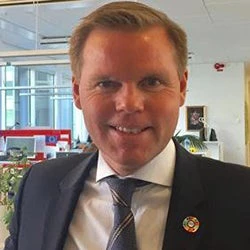
Our plane landed on an almost dirt airstrip, precariously carved out from among the bushes in Uganda’s northern District of Adjumani, which has a border with South Sudan to the northwest. The district is home to some 227,000 refugees, who make up close to 60% of the total population. Immediately after disembarking, we drove off on a dirt road, flanked by tall, green corn fields, banana palm and mango trees, which created a sea of vegetation – parted here and there by narrow lanes leading to mud huts. As we approached the district’s center, I tried to spot the usual tell-tale signs of refugee quarters, such as fences or other kind of demarcations.
There were none.
Instead, and to my pleasant surprise, there are no ring-fenced areas for the refugees. They live side-by-side with the local population. The integrated approach is not limited to Adjumani. In fact, Uganda has been praised for having the most compassionate refugee policy in the world. Here, refugees are welcomed warmly, given supplies and plots of land, and encouraged to integrate into society. Traveling on the dirt roads, it was impossible to say when the locals’ properties stopped and when the settlements of the newly arrived started. They also share public services in the community, such as hospitals, health clinics, schools, energy, water supply and other services.
Even the word “camp” is frowned upon by the government officials, who proudly call the lodgings “settlements.”
As the World Bank Group’s (WBG) Special Representative to the UN, I traveled to Uganda last month to join the Uganda Solidarity Summit on Refugees. UN Secretary General António Guterres and Uganda President Yoweri Museveni invited the international community in an effort to draw attention to the situation in Uganda.
Uganda is currently hosting more than 1.3 million refugees which is more than any other African country. Some 75% of the refugees come from South Sudan, most fleeing from violence and some escaping the looming famine. Given the sudden influx - an average of 2,000 people arriving daily since July 2016 – the pressure on the public services and local resources is immense and the authorities and the locals are visibly struggling to keep up.
Beyond the sheer scale of the influx, the profile of the refugees is striking: some 60% are children. I saw few men. Most refugees are extremely poor and bring hardly any resources with them, be it monetary or professional skills. Compare that to the many well-educated professionals who are flowing into Europe, of which less than 15% are children. Without support for education and skills development, the potential for refugees to contribute to Uganda’s development is clearly limited in the immediate future.
To sustain this level of solidarity from the host community, it is important that the local people feel that they are also benefiting from their own generosity. There is a strong argument for promoting longer-term development efforts – such as infrastructure or business investments – to ensure that these districts benefit as a whole, which can also ease the acceptance of new comers. As it turns out, at least in Uganda, the same areas where the refugees are settled are also the most disadvantaged parts of the country with extreme rates of poverty. For instance, some 43% of the residents in the northeastern sub-region live for less than one dollar a day (2012/13). Where else can development interventions be more relevant, especially if your goal is to end extreme poverty and promote shared prosperity?
On the pledging day, Secretary General Guterres and President Museveni co-chaired the summit, which raised some $358 million in pledges – short of the $2 billion target but still a sizeable commitment. The SG called the summit a “good starting point,” and asked the international community to continue supporting refugees and their Ugandan hosts.
The World Bank (WB) is already contributing through a USD50 million credit, aimed at improving access to basic social services, expanding economic opportunities, and enhancing environmental management for host communities. The Bank will further provide additional support to Uganda on very favorable terms through a new IDA18 sub-window to finance medium- to long-term investments that will benefit both refugees and host communities.
The WBG is also strengthening collaboration with the UN and other humanitarian partners so that we can work in complementary ways to benefit both refugees and host communities and better manage the transition from emergency assistance to longer term development solutions. In that regard, the Refugee and Host Population Empowerment (ReHoPE) strategic framework, which is a joint initiative by the government, UN partners and the WBG, represents a key building block to bridge the gap between humanitarian and development initiatives and to have transformative impact. The premise is that when communities recognize that refugees are agents of development who positively contribute to the sustainable development of their district, the refugee asylum space is both strengthened and expanded. One important aspect is that the investments from the program should be targeting both refugee and host communities. The implementation and monitoring of this commitment is difficult yet critical.
To me, this seems a perfect illustration of how the WBG can contribute to delivering on the humanitarian-development nexus. It is rewarding to see the strength of the WBG’s collaboration with the UN and other humanitarian actors in the field, and how it is progressing in tandem with efforts at HQ-level, as demonstrated through the recently signed UN-World Bank framework to build resilience and sustain peace in conflict areas.


Join the Conversation